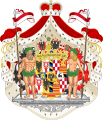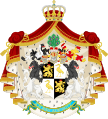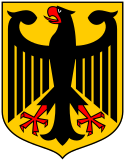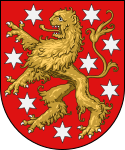Herb Turyngii
Herb Turyngii znany jest od XII wieku. Przedstawia na tarczy w polu błękitnym wspiętego srebrnego lwa w poziome czerwono-srebrne pasy,ze złotą koroną i szponami. Wokół lwa osiem srebrnych gwiazd.
Herb w obecnej wersji przyjęty został 30 stycznia 1991 roku. Potwierdzony został w konstytucji landu z 25 października 1993 roku.
Osiem gwiazd wokół lwa symbolizuje osiem historycznych terytoriów, które wchodzą w skład obecnej Turyngii. Są to: Sachsen-Weimar-Eisenach, Sachsen-Meiningen, Sachsen-Gotha, Sachsen-Altenburg, Republika Reuss (Księstwo Reuss (linii starszej) oraz Księstwo Reuss (linii młodszej)), Schwarzburg-Sondershausen i Schwarzburg-Rudolstadt oraz terytoria pruskie (Merseburg i Schmalkalden), które 1 maja 1920 roku wspólnie utworzyły ten kraj związkowy.
W latach 1920-1933 herbem Turyngii była tarcza z siedmioma srebrnymi gwiazdami (w układzie 2,3,2) w polu czerwonym. W okresie III Rzeszy paskowany lew trzymał w łapie swastykę. W początkowym okresie istnienia NRD Lew był złoty, a tło czerwone, w 1952 roku herb, jak i cała Turyngia jako jednostka administracyjna została zniesiona.
Historia
Schwarzburg-Sondershausen 1599-1918
Schwarzburg-Rudolstadt 1599–1918
Saksonia-Altenburg 1602–1672 i 1602–1672
Saksonia-Meiningen i Hildburghausen 1680–1918
Saksonia-Hildburghausen 1680–1826
Saksonia-Gotha-Altenburg 1672–1826
Księstwo Reuss (linii starszej) 1778–1918
Księstwo Reuss (linii młodszej) 1806–1918
Saksonia-Weimar-Eisenach 1809–1918
Saksonia-Coburg-Gotha 1826–1918
Media użyte na tej stronie
Autor: Glasshouse using elements by Sodacan, Trondivers and katepanomegas, Licencja: CC BY-SA 4.0
Coat of Arms of the Duchy of Saxe-Coburg and Gotha
Autor: Glasshouse using elements by Sodacan, Trondivers and katepanomegas, Licencja: CC BY-SA 4.0
Coat of Arms of the Grand Duchy of Saxe-Weimar-Eisenach
Autor: Glasshouse using elements by Sodacan and Trondivers, Licencja: CC BY-SA 4.0
Coat of Arms of the Duchy of Saxe-Altenburg
Autor: Glasshouse, Licencja: CC BY-SA 4.0
Coat of Arms of the Principality of Schwarzburg-Sondershausen. These arms differ from Schwarzburg-Rudolstadt in that the crest bears a princely hat and the base field is Or.
Coat of arms of the German federal state of Thuringia in the years 1945-1952.
Autor: Glasshouse using elements by Sodacan, Tom-L and Katepanomegas, Licencja: CC BY-SA 4.0
Coat of Arms of the Principality of Reuss-Greiz, Younger line. These arms differ from those of the Principality of Reuss-Greiz, Older Line, in that the lion supporters are black and white
Autor: Glasshouse using elements by Sodacan and Trondivers, Licencja: CC BY-SA 4.0
Middle Arms of the Duchy of Saxe-Altenburg
Autor: Glasshouse, using elements of Sodacan, Trondivers and Avalokitesvara, Licencja: CC BY-SA 4.0
Coat of Arms of the Duchy of Saxe-Meiningen-Hildburghausen
Autor: Glasshouse, Licencja: CC BY-SA 4.0
Coat of Arms of the Principality of Schwarzburg-Rudolstadt. These arms differ from Schwarzburg-Sondershausen in that the crest bears a princely crown and the base field is Argent.
Autor: Glasshouse with elements by Sodacan, Licencja: CC BY-SA 4.0
Shield of Saxe-Meiningen-Hildburghausen
Wappen des Landes Thüringen aus der Zeit der Weimarer Republik
Coat of arms of Thuringia 1933–1945
Autor: Glasshouse using elements by Sodacan, Tom-L and Katepanomegas, Licencja: CC BY-SA 4.0
Coat of Arms of the Principality of Reuss-Greiz, Older Line. These arms differ from those of the Principality of Reuss-Greiz, Younger Line, in that the lion supporters are all gold





























